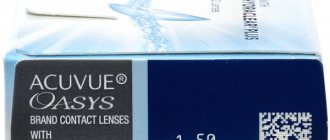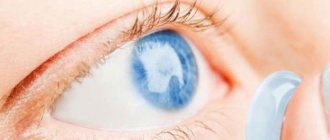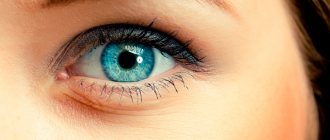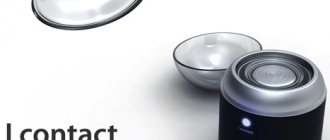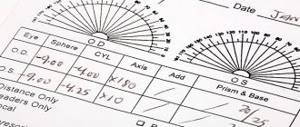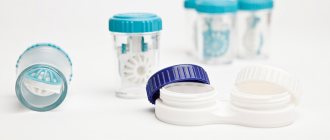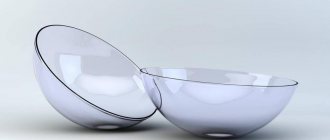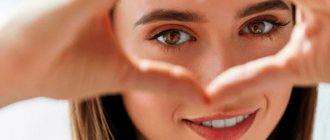Vision testing in optical salons
Many people, noticing that their vision has become worse, are at a loss where to turn for help. The clinic seems more reliable to them, because there are doctors there, and no one knows who is in the optics. In our optics, appointments are conducted by an Optometrist - a certified specialist with extensive experience in the field. Is it worth checking your eyesight at an optical salon?
Clinic or optician?
Often the choice falls on the clinic. After making an appointment with a doctor and arguing with other visitors in line, he finally ends up in the ophthalmologist's office. Everything happens very quickly here, because other visitors are already waiting outside the door. In the best case, having learned that the patient came specifically for glasses, the doctor will check visual acuity using a table with letters. Next, he clarifies where the patient cannot see, and, based on his answers, writes a prescription for glasses. A joyful man comes to the optician and orders glasses according to his prescription. After making it, it turns out that he is not comfortable. After suffering for several days, the buyer turns to the optician with a claim that the glasses were manufactured incorrectly. The optician checks the glasses and, as a rule, they completely correspond to the prescription. Why are there complaints?
Ophthalmologist or optometrist?
To understand the cause of complaints, salon workers suggest having your eyes checked by their specialist. The client is invited to the office, where the optometrist talks with him, tries to find out the reason for the dissatisfaction and devotes maximum time to each moment of selecting glasses. Acting according to a certain algorithm, the specialist must pay attention to the following things:
- how a person uses glasses, for what purposes;
- how much does he work on the computer?
- does he drive a car?
- does it need simultaneous correction for both distance and near.
Next, an inspection is carried out using a refractometer. This is a special apparatus for objective determination of refraction. After which the actual selection of points begins. Visual acuity is checked, a suitable lens is selected, necessarily for each eye separately! When the selection is completed, the patient opens both eyes and is allowed to spend some time in the selected correction. They ask about his feelings, do the same complaints arise as with manufactured glasses? It often happens that the clinic writes out a prescription based on certain age indicators, and not on the person’s subjective feelings. The doctor simply does not have time for a thorough consultation.
Lenses or glasses?
If you are faced with a question: glasses or contact lenses?
Contact lenses are no longer news, however, the number of questions that arise for anyone who is thinking about replacing glasses is only increasing. Most often, doubts are associated with the fear of the presence of something foreign in the eye and accompanying pain. However, minor inconveniences (in no case pain) arise only during the first fitting. Usually this is a sensation that when blinking, the inner surface of the eyelid feels the edge of the lens, which gradually disappears.
Subsequently, if the contact lens is selected and inserted correctly, you should not feel it more than your own eyelid. As for the question of whether you can wear contact lenses, the answer depends on the characteristics of your eyes, the recommended lenses and, most importantly, the qualifications of the doctor. There is no doubt that most people can use contact lenses if they so desire, provided they are fitted and fitted correctly. Meanwhile, many people have friends who, having bought lenses, do not use them for various reasons.
Such “failure” is mainly associated with incorrect and hasty selection, which is subsequently aggravated by even more incorrect care.
The most important factor in safe and proper contact lens wear is having a qualified physician provide eye examinations, appropriate lens fittings, and necessary follow-up care.
However, the patient himself also bears his share of responsibility for strictly following the established rules for handling contact lenses, for when to wear them and when to remove them, for keeping them clean, as well as for periodically undergoing preventive examinations (it is recommended to undergo them once every six months). Anyone who wears contact lenses has a unique experience - first you learn to live with them, and then you realize how annoying it is not to have them.
Why do we need contact lenses at all?
For most people, considerations of beauty and the desire to basically get rid of glasses come to the fore, although in fact contact lenses have many other advantages:
- Vision becomes more natural, the sizes of objects are closer to real ones. Wearing glasses, the shape and size of objects may appear distorted.
- There are no distortions during eye movements that are typical of glasses, since contact lenses move with the eye.
- The field of view is not limited to the frame of the glasses. This is especially felt when driving a car or playing active sports (tennis, alpine skiing, football)
- When it rains or snows, drops or snowflakes do not fall on the lenses.
- Contact lenses do not fog up when temperature and humidity change.
- If you need vision correction that is very different in its parameters for each eye, then contact lenses may be the only way in which both eyes will act in harmony.
- Some people with a tendency to squint achieve better control of oculomotor activity.
- Wearing contact lenses usually reduces the need for frequent vision correction changes.
- Special therapeutic contact lenses can protect the cornea while it heals.
- Sometimes contact lenses are the only way to ensure good vision when the cornea is damaged and has an irregular shape.
- Special contact lenses can form the pupil, replacing a deformed iris that is missing due to injury or disease.
- On a blind eye that is very different from the healthy eye, contact lenses can be used for cosmetic purposes to simulate a pupil and iris similar in appearance to the other eye.
However, contact lenses are not an alternative to glasses; they are one of the methods of vision correction; they can be alternated as needed. You decide for yourself in which situation you will be more comfortable with glasses and in which with contact lenses.
For unknown reasons, there is a widespread belief that contact lenses are only suitable for correcting myopia, although in fact they are suitable for any refractive error that can be corrected with glasses (farsightedness, astigmatism), and sometimes, significant improvement in vision can only be achieved using contact lenses lenses (keratoconus, aphakia and high degree astigmatism).
Even presbyopia (or age-related changes in vision), in which correction is required only for working at close range, is no longer an exception. It is clear that it is impossible to constantly remove and put on lenses in order to examine the necessary objects at different distances. Therefore, special presbyopic (multifocal) lenses have been developed and are already in use.
There are two main types of contact lenses - hard and soft lenses. Soft lenses absorb moisture. When a soft lens dries out, it loses its flexibility and becomes brittle, but a hard lens has permanent properties, regardless of whether it is wet or dry. Soft contact lenses are characterized by significant convenience and comfort almost from the first use. Hard lenses provide a sharper and clearer image. Astigmatism can be easily corrected with rigid gas-permeable lenses; with a small degree of astigmatism, correction with soft toric lenses is also used. Another advantage of hard lenses is that they are more durable and easier to clean.
Modern lenses (rigid gas permeable and soft silicone hydrogel) are manufactured in such a way that they provide the constant air exchange and contact with tears necessary for the cornea.
For soft contact lenses, the material of which accumulates deposits more quickly, a regime of frequent scheduled replacement is more preferable. Soft lenses can absorb and accumulate biological components of tears, corneal waste products, and chemicals from lens cleaning solutions, which can have a negative effect, especially when wearing lenses for a long time. Wearing lenses beyond the lens replacement period recommended by the manufacturer leads to the development of conjunctivitis, keratitis and further limitation of the ability to use lenses. Do not violate the rules for wearing, caring for and replacing contact lenses.
Deciding which contact lenses are right for you depends on many factors, but if your doctor thinks either type may be right for you, it may be best to try lenses with higher oxygen permeability and more frequent changes first. After selecting the lenses, the doctor will explain in detail how to wear the lenses, care for them and provide a special reminder that you can use at home. Will prescribe a schedule for subsequent visits. However, it is very important to catch the moment when something serious begins to happen.
Regardless of what kind of lenses you have, pay attention to the symptoms, if they appear, you should consult your doctor:
- Severe redness of the eyes.
- Burning sensation or severe irritation.
- When wearing or after removing lenses, a feeling of pain or severe discomfort occurs
- Intolerable sensitivity to light.
- Decreased vision and/or the presence of a colored halo around the light source.
- It's hard to open your eyes.
- In any case, no matter how much you want it, never rub your eyes while wearing contact lenses.
With the advent of high-quality colored contact lenses, it became possible to change the color of the eyes at will. This also applies to people with 100% vision, since colored lenses can have zero optical power.
Colored contact lenses are divided into tinted ones (which enhance the natural shade of light eyes) and actually colored ones, which radically change the color of the eyes. The center of the colored lens is transparent, so the background color does not change as with colored glasses. You should also select such lenses from an eye doctor, since the base curvature and diameter of the lens must exactly match the individual parameters of your eyes. An unsuitable lens can rub the eye and lead to serious illness. Careful care is necessary for all types of lenses, and colored lenses have their own characteristics, which must be precisely clarified when purchasing.
There are contact lenses that protect the eyes from ultraviolet rays; they can be used constantly or for stay in places with increased solar radiation (in the mountains, at the sea). However, eye protection with the additional use of sunglasses with a UV block is considered more reliable.
Don’t forget about regular preventative checks - this will help you avoid problems when wearing lenses, make timely adjustments and keep abreast of everything new that is related to contact correction. Save your eye doctor's contact information so you can contact him if necessary.
Take care of your eyes and when buying contact lenses, remember that this is not shampoo or lipstick, which can be endlessly replaced with others without harm.
When used correctly, contact lenses are one of the most convenient ways to solve vision problems.
Try it and see for yourself!
Free vision test in optical salons
A competent optometrist will conduct a full selection of glasses and can recommend certain lenses based on the data that the client told about himself. Nowadays the choice of spectacle lenses is huge, many of which ophthalmologists are not even aware of. There are lenses in which a person will see both far and near equally clearly. There are special anti-computer lenses, there are polarized ones, which are comfortable for driving and fishing, for playing sports, and so on. In our Opticians salon with vision testing, you can always choose ready-made glasses or order glasses made according to your results.
Now it is worth noting that an ophthalmologist and an optometrist are slightly different specialists. The doctor has a higher medical education, he can diagnose and treat eye diseases, but, unfortunately, very little training time is allocated to selecting glasses. In turn, an optometrist has a secondary education as a medical optician, and the entire annual training process is aimed specifically at selecting glasses.
Specialists who have completed a course in optometry can not only choose the right glasses, but also explain to the patient the difference between spectacle lenses, and choose exactly those lenses that are best suited for this particular person to meet his needs.
In conclusion, we note that the choice, of course, is always up to the client! But don’t be afraid of optics; if you need glasses, they will tell you and show you much more here than in the clinic. The most important advantage in favor of an optical salon is that the patient will be given maximum attention, everything that is not clear will be explained, or even demonstrated with visual samples.
Table for checking vision with an ophthalmologist (Sivtsev)
The table for checking visual acuity by an ophthalmologist (ophthalmologist) belongs to the standard set of vision diagnostics. It uses 7 letters: “SH”, “B”, “M”, “N”, “K”, “Y”, “I” in various combinations (there are no other letters!).
These signs, called “optotypes,” are equal in width and height in each row, decreasing in size from top to bottom.
Below is the Golovin-Sivtsev table, most widely used in the USSR and the current Russian Federation, despite the fact that clinics are increasingly using sign projectors from foreign manufacturers (Latin letters, rings with breaks, etc. can be shown).
What do the columns mean?
On the sides of the letters you can see two columns intended for the person conducting the study (ophthalmologist or optometrist):
D=50-2.5 This letter is derived from “Distance”, i.e. the distance from which a person with 100% vision sees this line (in meters). Thus, the topmost line of “ШБ” is from 50 m, the tenth line is from 5 m (the standard distance when examining vision at an ophthalmologist).
V=0.1-2.0 In this case, the indicator means “Visus” or visual acuity. Those. if from 5 m (standard distance) a person sees only the second line of “LSK”, then he has V = 0.2 (or 20% of the norm), etc.
